Hey friends! Been a bit since the last update, my apologies for that.
So, we’ve just learned about Ange’s miserable life after the Rokkenjima mass murder incident. Abused by her new guardian Eva, isolated in the school for terrible rich people, the only company she has is the ghost of Maria. Luckily, Maria is a total sweetheart and introduced Ange to her lion friend, who got multiple CGs. I’m sure this won’t be important at all.
The next chapter is titled The Future 12 Years Later, which is to say, October 1998—around the time that Ange is due to disappear into the game.
It opens with a quick establishing shot of the outside of a high rise building…

…before bringing us the talksprite of a new character, a man with ear piercings and a ponytail.
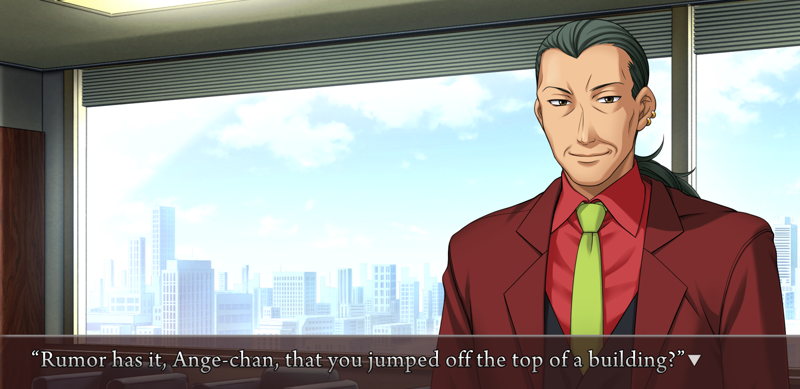
Apparently in this timeline Ange survived her apparent suicide—she didn’t disappear into the mysterious witch dimension, or appear to die. That’s interesting. Could we consider this to, after all, be the ‘prime’ timeline? So in fact Eva really did survive, not just in the particular bubble dimension of episode 3, but in the ‘source’? That’s a huge clue if so. Guess we’d better keep an eye on Eva this time around.
Anyway, Ange’s in a megacorp’s swanky conference room, sitting in a chair usually enjoyed by ‘executives with salaries probably north of twenty million yen’, which in today’s money is about $150k. It turns out there was a safety net because they were remodeling the lower floors. I feel about ready for Beatrice to redtext something like ‘there are no safety nets or devices that could save a falling person’ but I think that’s jumping the gun a bit.
That said, Ange’s landing was apparently a ‘miracle of miracles’:
She had shot through several layers of safety netting for the remodeling project, been caught by a multi-colored banner adorning the atrium, slid down and off it, …been softly caught by a final banner, landed on the ground without a scratch, and then left that place at a brisk walk… It put Hong Kong movies to shame.
Mysterious new guy says, well, you got really lucky. Ange is like, eh, “if I died, then that would be the end of that”. So it wasn’t exactly not a suicide attempt. She was “testing her luck”. This amuses the new guy, who seems to have known Kinzo and his obsession with gambling.
They start talking about the 須磨寺 family, i.e. Kyrie’s family, although she did not have a good relationship to them. The Sumaderas are a strict, old-school family from Kyoto—so not surprisingly Kyrie did not get on with them.
We hear a little about Ange’s grandpa, Kyrie’s dad. He married into the Sumaderas, and had a strained relationship with his wife that left him alienated from his new family. Because of this estrangement, Ange never met the Sumaderas until Kyrie’s funeral, where they immediately tried to claim her…
And yet, they had appeared for the first time at my parents’ funeral, shamelessly going on about how I’d grown, like they could actually act like a family after all this time…
…obviously angling for that juicy Ushiromiya inheritance.
Eva has died at this point, so Ange now has all the money. The new guy is a ‘corporate heavyweight’ entrusted with running Eva’s business group, and her only confidante after Hideyoshi’s death. He’s curious about what really happened on Rokkenjima.
We get some valuable information: when the ‘accident’ happened, Eva was two kilometres from the mansion, alone. Well, we know of three places on Rokkenjima: the main mansion, Kuwadorian, and wherever the gold is. Presumably Eva did in fact find the gold.
They discuss the public narrative of what happened: Kinzo was unsure who to award the inheritance, so he set the riddle of the gold. But, the new guy supposes, he probably intended Eva all along, and simply leaked her the answer so she could ‘solve the riddle’ and get the headship. Kuwadorian comes up, so that’s not a secret anymore.
Ange’s like, lol, sure my guy, Eva 100% did it though. His argument is
- Eva had Kinzo’s head ring.
- Eva truly was more capable than Krauss the business dunce, so Kinzo would want to give her the headship.
Ange gives the obvious retort: maybe she killed Kinzo to take that ring. New guy adds:
- Eva treasured Hideyoshi and George, and wouldn’t murder them. She cried a lot at the funeral.
This is a more persusasive point to Ange. New guy argues that even he would suspect Eva if Hideyoshi and George had lived. But she still suspects Eva, in the absence of any clear evidence to exonerate her. (No ‘innocent until proven guilty’ in the court of Ange!) So point 4 is…
- The police did a thorough investigation and found nothing on Eva.
Ange still doubts. So the Devil’s Proof comes out: it’s impossible to prove innocence. The new guy was evidently fond of Eva, and Ange despises her, so they come to different conclusions.
I have to wonder: in this entire discussion, the actual nature of the ‘accident’ hasn’t been described at all. What condition were the bodies found in?
Anyway, new guy says the root of this disagreement, and in others, is about ‘whether you have love’.
Depending on whether you feel love for the other side, the way you see things is completely different.
If a person you like gives to the poor, you can respect them, right? But if someone you hate starts donating, you fiercely protest that it’s a publicity stunt or they’re handing out favors.
Which he extends to say…
……As for me, I think that perhaps, except in extreme cases, truth (真実) in this world doesn’t exist (存在しない).
And even if it does, whether you believe it is predicated on love. Ange is (paraphrasing) going to be applying strong motivated reasoning and confirmation bias to support her belief that Eva dunnit.
I’m quoting this in detail because I’m pretty sure this is setting up a Big Theme. Maybe we’ll finally see what the deal is with that memetic ‘without love, it cannot be seen’ line.
So, new guy argues (please give him a name already!), it’s like Ange is looking at the truth with only one eye. She needs another eye in a different position: weigh up multiple competing hypotheses at once. And for that matter, read multiple newspapers. Then he says the line:
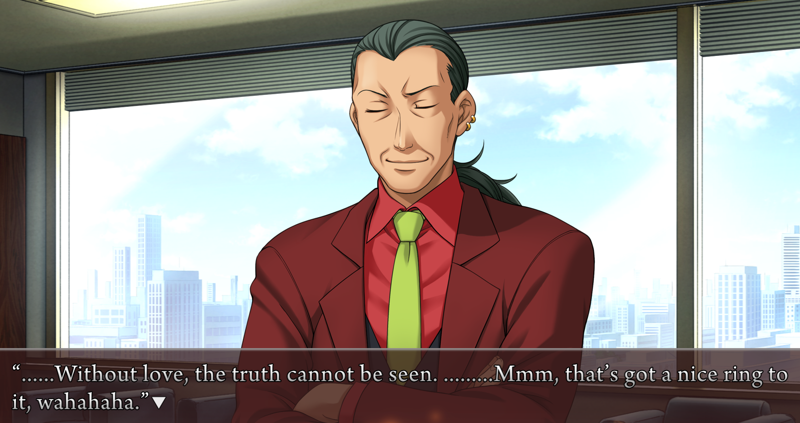
Since this is our arc phrase, let’s get it in Japanese.
愛がなければ、真実は見えない
In narration, Ange immediately calls this phrase cheesy.
We finally learn this man’s name. He’s Okonogi-san, and he appears on the character screen on a new pane called the ‘Ange side’ (along with the Human side and the Witch side). Here’s the full description:
- Okonogi Tetsuro (小此木 鉄郎)
-
A major player in the Ushiromiya Group. After Eva’s death and until Ange succeeds the group, he and the other ministers are the ones managing it.
However, since Ange has no desire to do so, the group is on the brink of internal discord, putting him in a difficult position as well.
He was previously the president of a foodstuff distribution company, and had a very close relationship with Hideyoshi’s company.
Becuase of that long-lasting association, Eva particularly trusted him, and he was appointed ot a significant post in the group.
And here are the other Ange Side entries:
- Ushiromiya Eva
-
After being repeatedly hospitalized from psychogenic stress, she is already dead in the world of 1998 due to acute heart failure.
The only survivor from Rokkenjima, she lived her later years in isolation with no one to understand her. The media gave her the name Queen Of Suspicion.
She continued on a path of reckless expansion like Kinzo had done in the past, and made many enemies.
In her later years, she seemed to do this repeatedly as if she found it funny, and at that point it was no longer for economic reasons, but simply to harass.
And all of this was for the sake of Ange, who would eventually succeed her.
- Ushiromiya Ange
-
Threw herself off the top of a skyscraper and miraculously survived unharmed. Her mystical experience led her to abandon everything and go on a personal journey to discover her past.
Will she, positioned twelve years in the future, be able to break through Beatrice’s magical power…?
So, off she goes, starting by getting in touch with ‘specialists and people related to the crime’. But just before she can go, the secretary brings some new info. It turns out that Ange’s plan is to, in Okonogi’s words, ‘sell off the whole shebang and donate the entire sum to social welfare’.
The Sumaderas won’t stand for this, and they send someone—Kyrie’s unnamed sister—to take Ange into their ‘protection’. A new, very tense music track kicks in with fast-paced drumming. Okonogi offers a taxi in the basement.
And Okonogi is playing both sides…
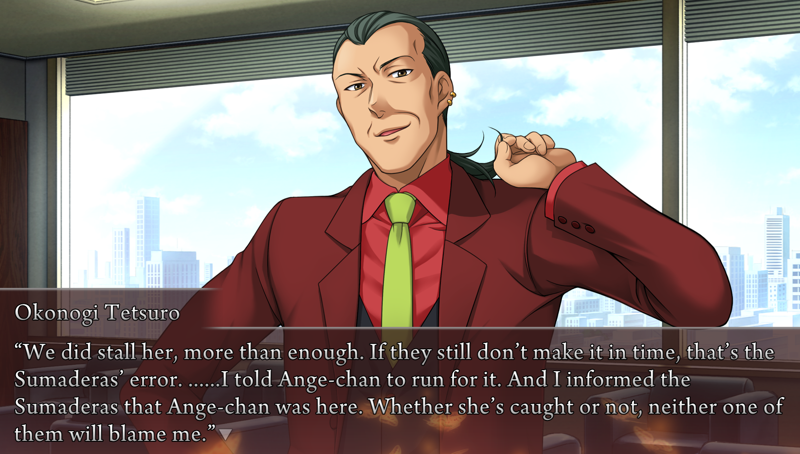
Interesting pose there!
Anyway, he believes she will escape.
Ange does indeed set about escaping. She makes her way out to the emergency stairs. We get a number of new backgrounds during this sequence, and I’m not gonna photograph every one, but do check out this car…

So a bunch of black-clad goons come out to try and apprehend Ange. Even for the hyper-rich, a kidnapping in broad daylight seems a little reckless lol.
Meanwhile, a new character enters at the front desk of the building. She pointedly refuses to give her name at the desk.
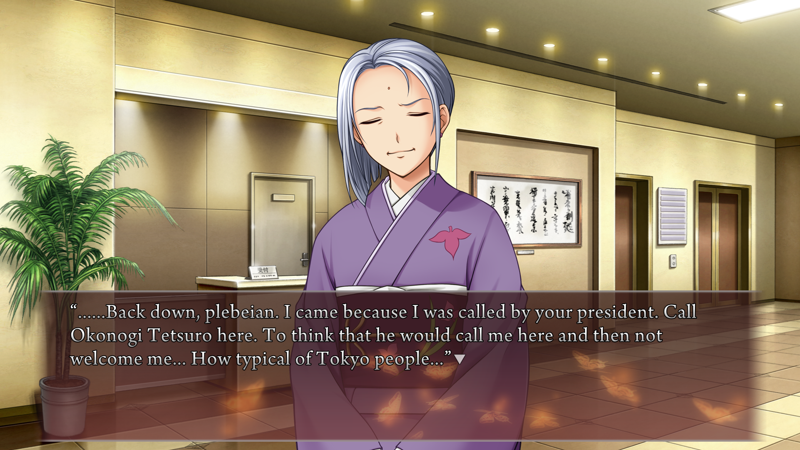
Whoever she is (presumably a member of the Sumadera family), she has a real chip on her shoulder about the uncouth behaviour of Tokyojin. The word translated here as ‘plebeian’ is 下賎, ‘low birth’. What an educational game this is!
Okonogi reveals that this is Sumadera Kasumi, and we get her entry.
- Sumadera Kasumi (須磨寺 霞)
-
Daughter of the declining noble family SUmadera. Ushiromiya Kyrie’s younger sister.
She hates her sister Kyrie so much that she loathes everything about her, so she also strongly hates Ange.
She is the opposite of the freewheeling person Kyrie was, and holds appearances in high regard, possessing a strong ambition for philanthropy. However, that is nothing more than a manifestation of her complex towards her sister, causing her to crave the limelight.
There are several opposing factions in the Sumadera family, and they are constantly engaged in a secret feud over who will control the vast wealth Ange holds.
Okonogi seems to know exactly how to handle her, needling her about her ‘provincial’ lack of punctuality which allows Ange to escape. She does not take it well. She talks about taking Ange to her ‘tea room’ where she has ‘the tools ready and waiting’. A joke, right…? Right…?
Meanwhile Ange continues her habit of insanely reckless parkour by pulling off a three-story drop down the outside of the emergency stairwell onto the roof of the goons’ car, which collapses to absorb the impact. The soundtrack gets really jazzy at this point.
Unfortunately a fourth goon is waiting in the car, and he pins Ange down! …and at this point yet another new character arrives as the cavalry, one Amakusa Juuza.
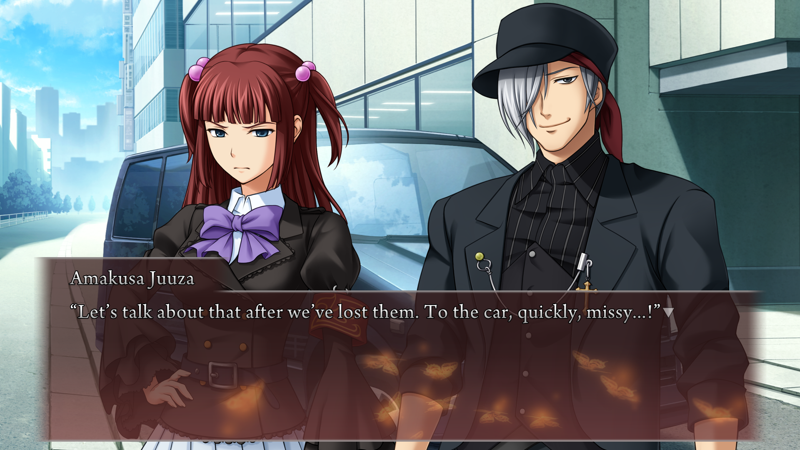
He calls her お嬢 without any further -san or -sama honorific (i.e. not oujosama), a polite form of reference for an someone else’s daughter, which the translation renders ‘missy’. He drives her away, weaving through traffic like in an action movie—a comparison explicitly made by the game. They exchange some quips.
Juuza: Any injuries, missy?
Ange: All good. Humans are surprisingly durable. From now on, whenever I miss a down elevator, I’ll just jump out a window instead.
Ange explains in narration who this guy is, but let me just quote his character screen:
- Amakusa Juuza (天草 十三)
-
A former guard of Eva’s.
An extreme thrillseeker who accepts dangerous jobs for little pay.He had served as Ange’s bodyguard before, but after he broke Eva’s strict order not to talk to Ange countless times, Eva ultimately took a dislike to him and let him go.
Ange herself didn’t find him all that bad, because he was someone she could talk to.
JSDF, Foreign Legion, private military companies—this man has traveled them all, and has skill in counter-sniping and escorting VIPs.
I looked it up and it seems PMCs were rapidly growing with the end of the Cold War, although I’m not sure where they would have been deployed. Hmm, if this is the 90s, that might mean he’s been involved in the Gulf War or the Yugoslav wars. Ange adds that he deserted both the JSDF and the French Foreign Legion, and can’t return to France without being arrested.
Right now it seems he’s working for… Blackwater. Which would have only just been founded at this point in history, so they wouldn’t have had the chance to torture anyone yet!
As for the reason he’s here… it seems Okonogi hired him, wanting Ange to owe him a favour. So the web of relationships is: Okonogi helped Juuza out after he got fired, Juuza was friendly to Ange, and Okonogi wants leverage over Ange so he called in his favour with Juuza. Anyway, Okonogi has hired him for just the weekend, but Ange immediately offers to hire him indefinitely—until the end of the investigation—for 100k a day. (Yen, presumably.)
This guy does feel like someone’s modern-setting RPG OC lol.
Back in the building, Okonogi plays it cool, although Kasumi doesn’t seem to be fooled. Serving matcha with an implied side order of torture is apparently Kasumi’s preferred form of threat, one Ange is aware of. Oddly specific but sure. Okonogi makes a quip about chazuke, which gets a cultural note…
- chazuke
-
chazuke (茶漬け), known as “bubuzuke” in Kyoto where Sumadera Kasumi is from, is green tea poured over rice with savory toppings.
It is said that in Kyoto, offering chazuke to a guest is often not meant sincerely, but is merely a way of indicating in a roundabout fashion that it is time for the guest to leave, and the guest is expected to know when to refuse.Effectively, in this scene, Tetsuro brazenly steals a phrase from Kasumi’s own cultural roots to tell her not to let the door hit her on the way out.
For someone who claimed to be playing both sides, Okonogi seems to be pretty firmly taking Ange’s here. Kasumi laughs it off with a nice little ohohojousama laugh, but makes a ‘demonic’ face as she leaves. (So that’s what those masks are called.)
With Juuza covering the tracks well, Kasumi’s play is to report Ange as a runaway to the police. The stakes are pretty high for her within her own family. She threatens her own goons with the ‘matcha’ torture. Seems like she’s just asking for a fragging with that kind of attitude. Notably during this scene, we can hear the ‘magic’ sound effect (sort of like a heavily distorted wind howling noise.) I don’t think this is saying ‘Kasumi is a witch’, but she’s displaying a witch-like vindictiveness perhaps.
We cut back to Ange and Juuza. It turns out all the measures that Ange took to dodge the ambush were misguided: there really was a car waiting, with Juuza in it no less. Ange, in turn, has some regrets about being quite so paranoid. We return to the theme that opened this chapter…
Because I wasn’t able to believe him, my truth, regardless of his truth, became “he sold me out”……
She repeats the phrase ‘without love, it cannot be seen.’
At this point, we pull back out into the witch dimension, and Bernkastel appears!

She says this is a ‘fragment’ after all—so any thought that we’ve glimpsed the elusive ‘prime’ world in this segment can be dismissed.
In any case, Ange is having a bit of an ontological crisis…
Ange: ……What is truth? There are as many truths as there are people. There are as many interpretations as there are people. And those can be twisted by opinions and changed indefinitely. ……Is truth really that indeterminate and vague?
Bernkastel: It is. ……Truth is indeterminate. It can be like a particle, or like a wave, and it can hold conflicting forms at the same time.
You are free to believe that the cat in the box is alive, or that it is dead. ……But the truth is very delicate. It changes its appearance just by being observed.
The philosophical doctrine Ange’s expressing here is known as alethic relativism. Bernkastel in turn invokes quantum mechanics. Ohoho, this is going to be fun to pick apart.
Let’s start then with wave-particle duality. This arises from the 19th-century debate between the ‘corpuscular’ theory of light first advanced by Newton, and the wave theory of light advanced in the weight of experiments in diffraction by people like Young and Fresnel. The evidence seemed to overwhelmingly favour the wave theory, and eventually it found a backing in Maxwell’s equations… but this all got overturned again in the early 20th century when puzzling observations like the photoelectric effect strongly suggested that light must come in discrete, indivisble chunks of energy, like particles.
The final theory that resulted from all this is quantum mechanics. Quantum particles—whether bosons such as photons, or fermions such as electrons—are neither classical particles like Newton’s corpuscules, nor continuous waves. Both the classical particles and the waves can be good approximations in the right circumstances, but the ‘reality’ is something altogether stranger, which needed a new mathematical and ontological framework to approach.
The second part is a reference to Schrödinger’s cat. This is a thought experiment proposed by Erwin Schrödinger in reaction to the debate about the interpretation of quantum mechanics. Strap in, OK?
Quick intro to quantum states
So! In quantum mechanics, the evolution of a quantum system is described by something called the ‘wave function’, which evolves according to (in the simplest case of nonrelativistic quantum mechanics) the Schrödinger equation.
What is the ‘wave function’? It is just a mathematical object. The wave function describes how the system corresponds to a set of possible ‘states’. These states might be, for example, ‘light polarised in the vertical direction’ and ‘light polarised in the horizontal direction’. Or they might be values of momentum or position or energy.
[2025 edit: It’s been pointed out to me that what I’m about to describe is really just a property of wave mechanics. You don’t need quantum mechanics to explain how polarised light works. Rather, in quantum mechanics everything else also works in a similar way to polarised light. At some point I will hopefully rewrite this with a better example.]
I’m not going to get into the full formalism here—suffice to say that, you do a quantum calculation, and it spits out some numbers which we can interpret as probabilities. e.g. a beam of light might be in a superposition which has probability 0.75 of being vertically polarised, and 0.25 of being horizontally polarised.
When you perform a measurement, you never directly see a superposition of light. You see light that is vertically polarised, or horizontally polarised. An electron that is spin up or spin down. Of course, to say ‘perform a measurement’ is rather vague—but just do something that gives information about the state in question. e.g. look through a polarising filter.
After this ‘measurement’, the system continues to evolve… starting from exactly the state you measured it to be. So if you observe that light is vertically polarised, and then measure whether it’s horizontally polarised, you will find that it is never horizontally polarised. This is why two polarising filters at right angles completely block all light.
Where it gets weird is if you use a different set of states that are related to the first set somehow. For example, you could measure whether the light is diagonally polarised, a state which can be represented as a combination of the horizontal and vertical states. It is easy to do this: put a third polarising filter in between the first two, rotated 45 degrees relative to each. We can think of this second polarising filter as a measurement device. Light either passes through it, at which point it has been measured to be in the diagonal state, or it does not, in which case it’s been measured to be in the perpendicular diagonal state. The probability of either is 50%.
Now, however, when the light reaches the third, horizontal filter… it is necessarily in the diagonal state (we measured it to be so!), which is once again 50% likely to pass through the horizontal filter. So, by adding an extra filter in between the first and third filters, we have made it so about 25% of the light can get through! Not a lot but still much more than 0%.
The word superposition refers to a property of solutions of the Schrõdinger equation. In solving a linear equation like the Schrödinger equation, you can build a wave function by adding together two other wave functions. We call such a sum of two states a ‘superposition’. Each component of the superposition evolves the same as ever.
So for example, say you have a birefrigent crystal that affects horizontally polarised light one way, and vertically polarised light a different way. Now you shine light into it that’s diagonally polarised. You can split the polarisation state into a sum (or superposition) of a vertical component and a horizontal component, work out what each one does as it goes through the crystal, and add the results back together. So a superposition is a combination of states that are, effectively, independent of each other.
Superposition is possible in any linear system, such as classical electromagnetism or vibrations on a string… but in the quantum mechanics this concept is very important, because a measurement in general takes you from a superposition of several states to one single state. For example, an electron could exist in a superposition of different position values as it passes through your experiment apparatus, a ‘cloud’ of probability density in space. But when you measure its position (e.g. by shooting it into a photographic plate), it appears in one specific place.
There are further weirdnesses: many quantities are ‘dual’ to each other, meaning if one is well-defined the other isn’t—so for example a state with a very precise position is also a state that is a superposition of many different possible values of momentum.
So, quantum objects are quite unlike classical objects. They can exist in superpositions of states (and indeed, given the possibility of different measurement bases, can always be considered a superposition of states), even interact with other quantum objects in superposition… and yet we necessarily only ever observe them in one state, not a superposition.
Having introduced the idea of quantum states, and said they are very weird compared to classical mechanics, the question comes—how come we never see things like superposition directly? What exactly is this ‘measurement’? This is where the idea of ‘interpreting’ quantum mechanics comes in.
The language used above comes from one of the prevailing ideas, the Copenhagen interpretation, which says that when you ‘measure’ a physical system, it ‘collapses’ its state down into one of the possible states described by your measurement device, the probability given by the Born rule.
However, this is very odd. We don’t know what exactly constitutes a ‘measurement’. Or what physical mechanism precipitates this ‘collapse’. The ‘collapse’ of the wave function is not unitary, unlike the rest of quantum mechanics. And it seems to divide the world into a ‘quantum’ part (the system) and a classical part outside it (the measurement device), which isn’t much good for a theory of everything.
We might think there is an escape route in the fact that quantum mechanics seems to only be relevant for describing things which are very small, so perhaps we ought to be able to just ignore these difficulties, because on the large-scale world, classical physics does just fine. However, Shrödinger’s cat is a thought experiment about how you could put a macroscopic system—something as significant as life or death—and put it into a quantum superposition.
What Schrödinger was getting at with the cat thing
Schrödinger contrived a situation where a cat’s life is determined by radioactive decay—a quantum process, which we can measure using a Geiger-Müller tube. The atoms in the radioactive sample are in a superposition of ‘decayed’ or ‘not decayed’. If they decay, the cat dies. So the idea is that the cat’s life is also in a superposition… until an observation is performed by opening the box and the cat’s wavefunction collapses into either alive or dead.
Schrödinger viewed this as an absurd conclusion. His thought experiment was a dismissal of the idea that quantum weirdness could be kept out of sight in the realm of very small particles, but it also seems like he considered it absurd to have a cat in a superposition. I’m not sure what his favoured interpretation of quantum mechanics was.
In any case, the various interpretations of quantum mechanics all have slightly different accounts of the thought experiment. In the Everett ‘Many Worlds’ interpretation for example, the universe continues in a superposition of ‘cat is alive’ and ‘cat is dead’, and when we open the box, we get entangled with the cat’s state and ourselves enter a superposition of ‘person who found an alive cat’ and ‘person who found a dead cat’. But this does not really answer why our conscious experience shows no superposition.
Schrödinger’s cat is not strictly speaking a paradox—there is no logical reason a cat couldn’t be in a superposition of states—but it does kind of get straight to the heart of the philosphical conundrums of quantum mechanics. For example, if I have not observed you recently, should I consider you to be in a superposition of states until I get the chance to observe your state? How do we account for all these different superpositions?
Practically speaking, all of these ‘interpretations’ give the same observable predictions by definition (outside of… questionable ideas like the quantum suicide experiment), but how to make sense of quantum mechanics is still a messy problem that we’re still debating a hundred years after quantum mechanics was devised.
In short, Schrödinger’s cat is a deliberately absurd thought experiment arguing against the possibility of macroscopic superpositions.
So, back to Umineko. Bernkastel explains that in order to deny all possible ‘armchair theories’, it is necessary to ‘open the box’. This is summed up in the pithy statement
As long as truth can’t be observed, it keeps its form.
Without this observation, any old lie can ‘exist as truth’ without being negated. So this is the form of the dialethism that prevails in this world. Even an absurd lie like the Ushiromiyas being imprisoned by a witch. Bernkastel says something interesting:

And Ange’s task is to open the box and reveal the real truth.
Notably this is not really a Schrödinger’s cat situation. There is, it seems, still one true underlying reality—a hidden variable in quantum mechanics parlance—which is hidden from us. It’s not like when Ange ‘opens the box’, it will collapse to ‘Beatrice is a witch’ with probability, say, 30%, and ‘Eva murdered everyone’ with probability 70%, and then that ‘truth’ will apply retroactively.
Ange, Bernkastel adds, is a special piece—the only one which can move freely in 1998.
Bernkastel: Beatrice’s game board spans the two days from October 4th to the 5th, 1986. In other words, this means that you are a piece who can move freely outside her game board. ……And even Beatrice cannot influence this future that lies outside the game board.
This makes her very powerful.
Ange brings up another physics analogy, this time the limited speed of light—how if a star exploded in Centaurus, we wouldn’t know for 4.5 years. Only when they get the information can the people of Earth figure out the real history. (Of course, with relativity of simultaneity in different reference frames, it’s even more complicated lol.) Until then, they would believe the star is still there.
She adds that, in the time since the incident, occult theories have become increasingly prevalent, possibly one day drowning out the murder theory entirely. This was prompted by the wine bottle with a letter inside it, which I recall was mentioned in the epilogue of the first episode. This bottle, Ange says, caused the witch to take control of the island retroactively.
Ange: …The witch tried to get out of the box. She made it so that she would be observed, weeding out all possibilities other than the witch theory. ……In other words, to make it impossible for herself to be negated, she negated all possibilities other than the witch theory.
………Well, I’ll be damned. So in other words, Beatrice satisfied the Devil’s proof with a frontal attack. And that was part of the witch’s plan from the beginning.
Bernkastel adds that, since this postdates the events on the island, it can only be observed by Ange—not Beatrice or Battler. To view the world in 3D with both eyes as Okonogi encouraged her, Ange decides to go and investigate that message in a bottle. Bernkastel throws out yet another mathematical analogy:
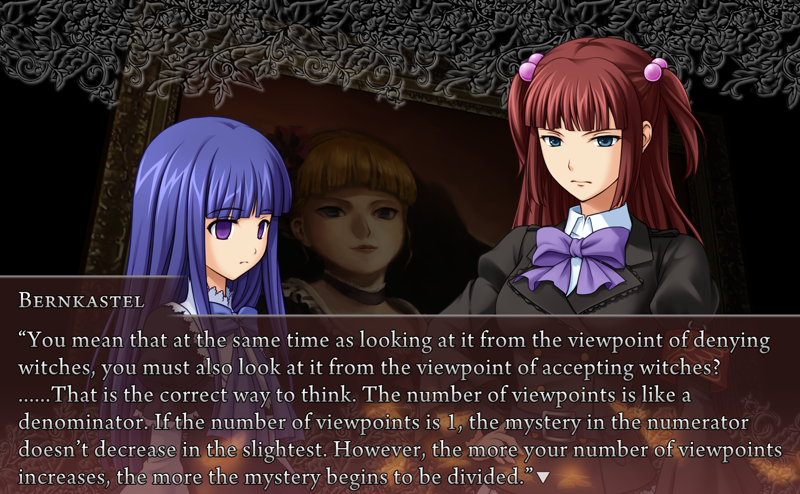
Phew, Bernie. That text box literally had to grow bigger to contain that little speech.
So Ange resolves to make an appointment with the ‘dilettante’ who discovered the bottle. And with that, we finally end the chapter.
The next one is called ‘red truth, blue truth’. Fucking hype, do you know how long I’ve been waiting for blue truth?
This chapter has given much to think about, but I think I’ll save it for the beginning of the next issue. Mostly we’re stage setting, by which I mean introducing new characters and setting up the major arc phrases and themes to be explored in this episode.
Also, apologies this one took so long after the last. I have been very busy with animation training, but I’ll try to hit a better schedule for the next!
Comments
cass (6384366eb2f79933c34a7e654153db06)
I just read your whole liveread over a few days and I’m loving all your thoughts so far! It’s always great to see people’s opinions evolve over the course of Umineko, and your thorough analysis of the various concepts both philosophical and cultural that come up are a real treat.
quiza
I’ve been reading along with your liveblog as I play through Umineko. Finding your thoughts really interesting! also appreciate you calling out the misrepresentations of physics, since they are about as accurate in as the chess metaphors…